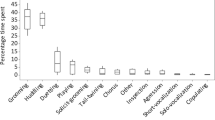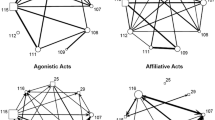Abstract
We examined social and spatial relations of adult males in one group of mantled howling monkeys (Alouatta palliata) on Barro Colorado Island (BCI) in central Panama to document patterns of association. Beyond the existence of an alpha male, we could not distinguish any linear dominance hierarchy among the 6 study males. All males copulated with estrous females. Our findings contrast with reports of intragroup male behavior in Costa Rican howlers. Study males engaged in little or no affiliative or agonistic behavior with one another, but engaged in significantly more such interactions with females. The alpha male, the oldest male and a younger male were most frequently in association with females. Of group males, the oldest male associated significantly more with other males. Overall, male behavior in mantled howling monkeys on BCI generally followed the van Hooff and van Schaik (1994) model of male relationships. The low incidence of intragroup social interactions of any type in the focal males may reflect the energetic costs of social behavior. We suggest that intragroup social relationships among mantled howler males are structured by more subtle means than overt physical interactions, possibly including vocal communication, relationships with individual group females, and kinship.
Similar content being viewed by others
References
Altmann, J. (1974). Observational study of behavior: Sampling methods. Behaviour 49: 227-267.
Altmann, S. (1959). Field observations on a howling monkey society. J. Mammal. 40: 317-331.
Baldwin, J. D., and Baldwin, J. I. (1976). Vocalizations of howler monkeys (Alouatta palliata) in Southwestern Panama. Folia Primatol. 26: 81-108.
Carpenter, C. R. (1934). A field study of the behavior and social relations of howling monkeys. Comp. Psychol. Monogr. 10: 1-168.
Carpenter, C. R. (1965). The howlers of Barro Colorado Island. In DeVore, I., (ed.), Primate Behavior: Field Studies of Monkeys and Apes. Holt, Rinehart and Winston, New York, pp. 250-291.
Chivers, D. (1969). On the daily behavior and spacing of howling monkey groups. Folia Primatol. 10: 48-102.
Clarke, M. R. (1982). Socialization, Infant Mortality and Infant-Nonmother Interactions in Howling Monkeys (Alouatta palliata) in Costa Rica, PhD Thesis, University of California, Davis.
Clarke, M. R. (1983). Infant-killing and infant disappearance following male takeovers in a group of free-ranging howling monkeys (Alouatta palliata) in Costa Rica. Am. J. Primatol. 5: 241-247.
Clarke, M. R. (1986). Interactions of adult male howling monkeys (Alouatta palliata) with immatures in a free-ranging social group. Am. J. Phys. Anthropol. 69: 188.
Clarke, M. R., and Glander, K. E. (1984). Female reproductive success in a group of free-ranging howling monkeys (Alouatta palliata) in Costa Rica. In Small, M. (ed.), Female Primates: Studies by Women Primatologists, Alan R. Liss, New York, pp. 111-126.
Clarke, M. R., Glander, K. E., and Zucker, E. L. (1998). Infant-nonmother interactions of free-ranging mantled howlers (Alouatta palliata) in Costa Rica. Int. J. Primatol. 19: 451-472.
Colmenares, F. (1991). Greeting, aggression, and coalitions between male baboons: Demographic correlates. Primates 32: 453-463.
de Waal, F. B. M. (1982). Chimpanzee Politics, Jonathan Cape, London.
de Waal, F. B. M. (1989). Peacemaking Among Primates, Harvard University Press, Cambridge, MA.
DeGusta, D., and Milton, K. (1998). Skeletal pathologies in a population of Alouatta palliata: Behavioral, ecological, and evolutionary implications. Int. J. Primatol. 19: 615-650.
Glander, K. E. (1975). Habitat and Resource Utilization: An Ecological View of Social Organization in Mantled Howling Monkeys, PhD Thesis, University of Chicago, Chicago.
Glander, K. E. (1980). Reproduction and population growth in free-ranging mantled howling monkeys. Am. J. Phys. Anthropol. 53: 25-36.
Glander, K. E. (1992). Dispersal patterns in Costa Rican mantled howling monkeys. Int. J. Primatol. 13: 415-436.
Hall, K. R. L., and De Vore, I. (1965). Baboon social behavior. In De Vore, I. (ed.), Primate Behavior, Holt, Rinehart and Winston, New York, pp. 53-110.
Hill, D. A., and van Hooff, J. A. R. A. M. (1994). Affiliative relationships between males in groups of nonhuman primates: A summary. Behaviour. 130: 143-149.
Hubbell, S. P., and Foster, R. B. (1990). Structure, dynamics and equilibrium status of old-growth forest on Barro Colorado Island. In Gentry, A. H. (ed.), Four Neotropical Rain Forests, Yale University Press, New Haven, CT, pp. 522-541.
Jones, C. B. (1980). The functions of status in the mantled howler monkey, Alouatta palliata Gray: Intraspecific competition for group membership in a folivorous neotropical primate. Primates 21: 389-405.
Jones, C. B. (1983). Social organization of captive black howler monkeys (Alouatta caraya): “Social competition” and the use of non-damaging behavior. Primates 24: 25-39.
Jones, C. B. (1985). Reproductive patterns in mantled howler monkeys: Estrus, mate choice and copulation. Primates 26: 130-142.
Kappeler, P. M. (2000). Primate males: History and theory. In Kappeler, P. M. (ed.), Primate Males: Causes and Consequences of Variation in Group Composition, Cambridge University Press, Cambridge, UK, pp. 3-7.
Leigh, E. G., Rand, A. S., and Windsor, D. M. (1982). The Ecology of a Tropical Forest. Smithsonian Press, Washington, DC.
Matheson, M. D., Johnson, J. S., and Feuerstein, J. (1996). Male reunion displays in tufted capuchin monkeys (Cebus apella). Am. J. Primatol. 40: 183-188.
Milton, K. (1980). The Foraging Strategy of Howler Monkeys, Columbia University Press, New York.
Mitani, J. C., Merriweather, D. A., and Zhang, C. (2000). Male affiliation, cooperation and kinship in wild chimpanzees. Anim. Behav. 59: 885-893.
Moore, J. (1992). Dispersal, nepotism, and primate social behavior. Int. J. Primatol. 13: 361-378.
Morin, P. A., Moore, J. J., Chakraborty, R., Jin, L., Goodall, J., and Woodruff, D. S. (1994). Kin selection, social structure, gene flow, and the evolution of chimpanzees. Science 265: 1193-1201.
Perry, S. (1996). Female-female social relationships in wild white-faced capuchin monkeys, Cebus capucinus. Am. J. Primatol. 40: 167-182.
Perry, S. (1998). Male-male social relationships in wild white-faced capuchins, Cebus capucinus. Behaviour 135: 139-172.
Pope, T. R. (1990). The reproductive consequences of male cooperation in the red howler monkey: Paternity exclusion in multi-male and single-male troops using genetic markers. Behav. Ecol. Sociobiol. 27: 439-446.
Robbins, M. M. (1996). Male-male interactions in heterosexual and all-male wild mountain gorilla groups. Ethology 102: 942-965.
Rowell, T. E. (1966). Forest-living baboons in Uganda. J. Zool. Soc. Lond. 147: 344-364.
Simonds, P. E. (1974). Sex differences in bonnet macaque networks and social structure. Arch. Sex. Behav. 3: 151-166.
Simpson, M. J. A. (1973). The social grooming of male chimpanzees. In Michael, R. P., and Crook, J. H. (Eds.), Comparative Ecology and Behaviour of Primates, Academic Press, London, pp. 411-506.
Smuts, B. B., and Watanabe, J. M. (1990). Social relationships and ritualized greetings in adult male baboons (Papio cynocephalus anubis). Int. J. Primatol. 11: 147-172.
Southwick, C. H. (1963). Challenging aspects of the behavioral ecology of howling monkeys. In Southwick, C. H. (ed.), Primate Social Behavior, D. Van Nostrand, Princeton, NJ, pp. 185-191.
Strier, K. B. (1994). Myth of the typical primate. Yrbk. Phys. Anthropol. 37: 233-271.
Struhsaker, T. T. (1975). The Red Colobus Monkey, University of Chicago Press, Chicago.
Struhsaker, T. T., and Leland, L. (1979). Socioecology of five sympatric monkey species in the Kibale Forest, Uganda. In Rosenblatt, J. S., Hinde, R. A., Beer, C., and Busnel, M. C. (Eds.), Advances in the Study of Behavior, Vol. 9, Academic Press, New York, pp. 159-228.
Strum, S. C. (2002). Book review: Primate Males. Int. J. Primatol. 23: 223-225.
Sugiyama, Y. (1971). Characteristics of the social life of bonnet macaques (Macaca radiata). Primates 12: 247-266.
Treves, A. (2001). Reproductive consequences of variation in the composition of howler monkey (Alouatta spp.) groups. Behav. Ecol. Sociobiol. 50: 61-71.
van Hooff, J. A. R. A. M. (2000). Relationships among non-human primate males: A deductive framework. In Kappeler, P. M. (ed.), Primate Males: Causes and Consequences of Variation in Group Composition, Cambridge University Press, Cambridge, UK, pp. 183-191.
van Hooff, J. A. R. A. M., and van Schaik, C. P. (1992). Cooperation in competition: The ecology of primate bonds. In Harcourt, S., and de Waal, F. B. M. (Eds.), Coalitions and Alliances in Humans and Other Animals, Oxford University Press, Oxford, pp. 356-390.
van Hooff, J. A. R. A. M., and van Schaik, C. P. (1994). Male bonds: Affiliative relationships among nonhuman primate males. Behaviour 130: 309-337.
Vehrencamp, S. L. (1983). A model for the evolution of despotic versus egalitarian societies. Anim. Behav. 31: 667-682.
Washburn, S. L., and Hamburg, D. A. (1968). Aggressive behavior in Old World monkeys and apes. In Jay, P. C. (ed.), Primates, Holt, Rinehart and Winston, New York, pp. 458-478.
White, F. J., and Chapman, C. A. (1994). Contrasting chimpanzees and bonobos: nearest neighbor distances and choices. Folia Primatol. 63: 181-191.
Young, O. P. (1981). Chasing behavior between males within a howler monkey troop. Primates 22: 424-426.
Young, O. P. (1983). An example of “apparent” dominance-submission behavior between adult male howler monkeys (Alouatta palliata). Primates 24: 283-287.
Zucker, E. L., and Clarke, M. R. (1986). Male-male interactions in a group of mantled howling monkeys (Alouatta palliata) in Costa Rica. Am. J. Primatol. 10: 443.
Zucker, E. L., and Clarke, M. R. (1998). Agonistic and affiliative relationships of adult female howlers (Alouatta palliata) in Costa Rica over a 4-year period. Int. J. Primatol. 19: 433-449.
Zuckerman, S. (1932). The Social Life of Monkeys and Apes, Harcourt, Brace, New York.
Author information
Authors and Affiliations
Corresponding author
Rights and permissions
About this article
Cite this article
Wang, E., Milton, K. Intragroup Social Relationships of Male Alouatta palliata on Barro Colorado Island, Republic of Panama. International Journal of Primatology 24, 1227–1243 (2003). https://doi.org/10.1023/B:IJOP.0000005989.29238.ce
Issue Date:
DOI: https://doi.org/10.1023/B:IJOP.0000005989.29238.ce




